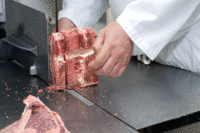As the global refrigerated and frozen food supply continues to grow in volume and complexity, companies in this industry are working to improve their supply  chains and make food safer for consumers.
chains and make food safer for consumers.
Overall projected growth rates of imported foods into the United States are 5-15% per year. This growth comes from consumers’ insatiable appetite for diverse food products, as well as the need for lower costs and high productivity. An FDA report, “Pathway to Global Safety and Quality,” estimates that between 10-15% of all food consumed in the United States is imported. And, according to the U.S. Government Accountability Office, imports account for nearly two-thirds of the fruits and vegetables and 80% of seafood eaten domestically.
FDA-regulated products come from more than 300,000 facilities in about 150 countries. With this new globally-spread supply chain come increased challenges such as being able to trace products and ensuring that food safety and quality are at the top of the list for companies and their partners. Also, with the increased risk of food supply terrorism, refrigerated and frozen food companies must be aware of both the partner and regions with which they are doing business. With more uncertainty and unpredictability, companies are increasingly realizing factors outside their direct control are having an impact on their supply chains.
Knowing your partners can help maintain a smooth flow of goods while ensuring safety and security. A good starting point is the Customs-Trade Partnership Against Terrorism (C-TPAT). However, refrigerated and frozen food companies must also look further into their supply chain security through the following:
C-TPATcertification. C-TPAT, launched in 2001, helps manage and monitor the movement of goods and reduce the possibilities of unknown elements accessing the shipper’s containers and shipments. C-TPAT—which gives companies access to the most accurate information on their supply chain’s security—requires examining all the possible ways a company moves goods, identifying countries and regions it is working with and assessing the risk of each partner. It requires manufacturers and partners to demonstrate security criteria via written/electronic confirmation. Initially obtaining C-TPAT certification may require some investment, but it can be a source of tremendous time and financial savings in the long run—from reducing the likelihood of audits and accompanying fines and lowering scrutiny from the CBP to reducing a company’s liability and speeding up the time to get goods.
Collaboration. Food companies canimprove their daily business operations byimplementing practices and tools that encourage real-time collaboration with partners. For example, robust web-based software platforms allow refrigerated and frozen food partners to access and provide accurate information and timely responses to questions not only on C-TPAT partner questionnaires but also on country of origin, qualification and certification of parts eligible for trade agreements. Companies can automate processing purchase orders, customs invoices and shipping information (container numbers, bills of lading, etc.) in one system. Partners/shippers can also provide and even upload supporting information on part attributes to increase accuracy in classification and avoid under- or over-paying duties and fees.
Due diligence. In this new global economy, due diligence and researching how vulnerable partners are and what possible threats to each region exist is critical. Refrigerated and frozen food companies can benefit from available software to automate such research, receive responses to questionnaires from partners and even perform on-site evaluations, when possible. Importers, who assume the risk of transactions and products, have the right to require a certain level of cooperation from partners in sharing information and collaborating online.
Improve internal practices. As corporate responsibility moves to the forefront of global business, it’s important for refrigerated and frozen food companies to analyze and audit not only their partners, but also their own practices. Keep in mind that evaluating yourself as a partner and supplier and making improvements where necessary can go a long way in the supply chain and for consumer sentiment.
Keeping a step ahead of the shift in the global supply chain and with partnership management can lead to greater daily business efficiencies, including a smoother flow of goods. It can also strengthen partnerships and ensure safer and better quality foods for consumers.


